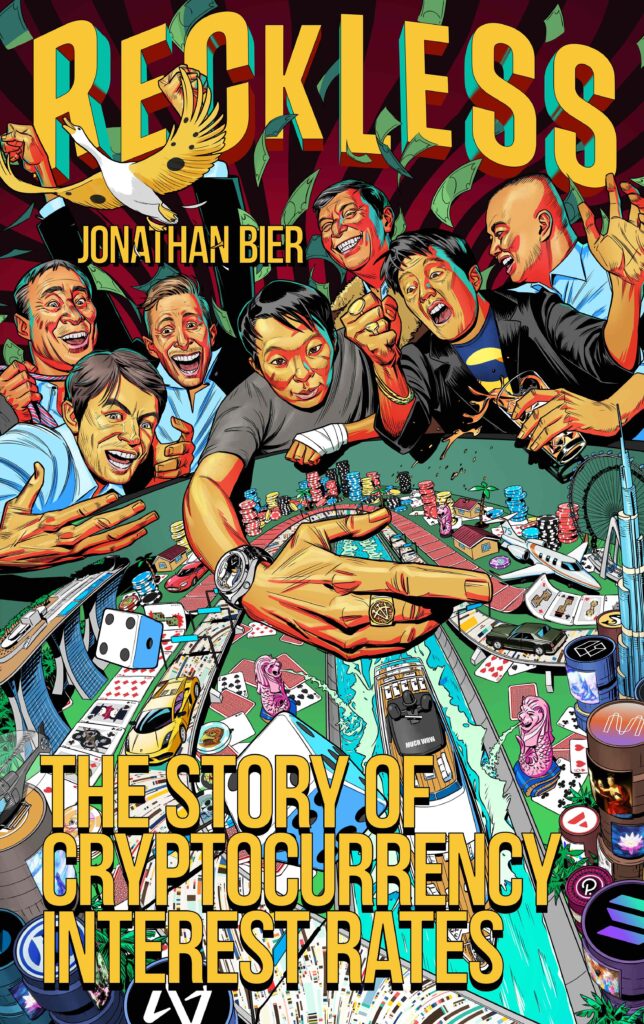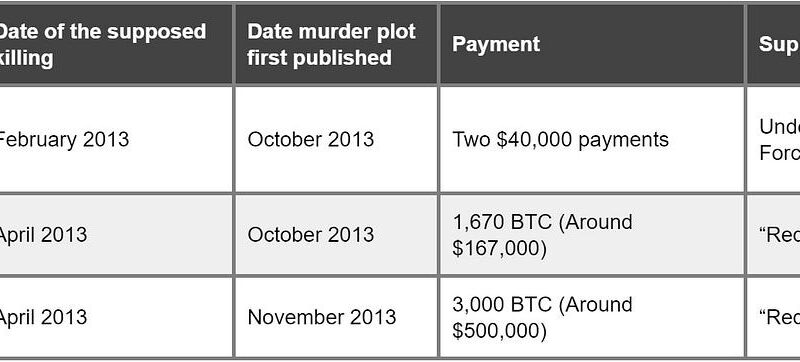Chapter 15 of the book Reckless: The Story Of Cryptocurrency Interest Rates is published below. The full book is available on Amazon. The book was written before the bankruptcy of FTX and therefore does not include coverage of this event. However, the book does provide useful commentary in the run up to the failure of FTX, which provides context for the eventual calamity.

The Luna Collapse
On 9th May 2022, the UST stablecoin began to lose its peg. It reached a low of US$0.79 on the day. Remember, the coin was constructed such that if it traded below US$1, new Luna tokens would automatically be issued out of nothing to prop up the price of UST. This structure created a potential opportunity for hedge funds, who could first short or borrow Luna and then short or dump UST, profiting when the Luna price declines because of the new issuance hitting the market. As UST lost its peg, rumours were circulating that a large sophisticated fund was conducting this exact trade. The so-called Soros style attack Do Kwon had called the “most retarded” idea. There was significant speculation inside the cryptocurrency community about which hedge fund this might be, including rumours about Ken Griffin’s Citadel Securities or investment management giant Blackrock. It is of course extremely unlikely that anyone associated with these entities was involved. If there was a hedge fund with a large balance sheet conducting this trade, it was likely a cryptocurrency specialist trading firm or former employees of one of these large firms.
Most traders did not seem to believe the intention of the short seller was to break UST completely. The plan could have been to cause it to trade at a significant discount, then cover the position. UST could then recover back to US$1. However, on 10th May 2022, UST continued to crash, reaching a low of US$0.68. The coin was incredibly volatile, trading as high as US$0.94 on the day. Many market participants now believed that the integrity of UST had been ruined and a recovery was unlikely. UST continued its price decline, on 11th May it traded between US$0.30 and US$0.85. Then by Saturday 14th May, it was all over, UST traded between US$0.14 and US$0.25. The coin remained extremely volatile, but continued its decline towards a price of a few cents, which it trades at today.
The UST failure was in spite of an attempted defence by the LFG, which used up its reserves. On 7th May 2022, the LFG had over US$3 billion in reserves, including over 80,000 Bitcoin. By 11th May 2022, this had plummeted to just over US$100 million.
This was all bad news for Luna, whose supply was skyrocketing as the system tried to maintain the US Dollar peg. The price of Luna was therefore plummeting. On the 5th May 2022, the price of Luna was around US$85 per coin, a market capitalisation of around US$30 billion. In this period, unsurprisingly the price of the coin crashed and on 11th May Luna reached a low of $0.85, before continuing its decline to a fraction of a cent, which it trades at today. Luna was seen as one of the hottest coins of 2022 and it was incredibly painful for many investors who were totally wiped out in just a few days. Almost US$30 billion of apparent value, up in smoke in a few days.
On around the 11th May 2022, it also emerged that Do Kwon was behind a stablecoin project called Basis Cash, which launched in 2017 and then collapsed. Do had used the pseudonym “Rick Sanchez” from the TV show Rick and Morty. Many UST investors were concerned by this, especially because it was not disclosed to them before they invested in UST. This was more painful for some investors as in a Tweet in December 2020, Do appears to criticise Basis Cash, calling it a “zero sum game”, while indicating UST was the “king”.
The failure of Luna caused a wider decline in cryptocurrency prices. Bitcoin fell from around US$40,000 to US$30,000, while Ethereum fell from US$3,000 to US$2,000 in the period. The failure of UST and Luna caused panic in some sections of the industry, as they did not know which counterparties had exposure and who to trust. In mid-June, about a month later, the market took another leg down. Bitcoin crashed from US$30,000 to US$20,000 and Ethereum fell to below US$1,000.
On Tuesday 14th June 2022, rumours started to circulate that 3AC was in trouble. 3AC had lost funds on the GBTC trade and had been a large supporter of Luna. Many counterparties had exposure to 3AC and they began to call back their loans. Many were observing 3AC’s known DeFi wallets on the Ethereum blockchain, assessing how they managed their leverage and exposure.
DeFi Demonstrates Its Advantages
In general, the DeFi platforms appeared to perform well in this crisis, just like the performance in the May 2021 crash a year earlier. If a trading firm was struggling to obtain the liquidity it needed to make margin calls, it would pay its DeFi obligations first. This is because these positions in DeFi are transparent and if the company wanted to avoid spreading panic about its solvency, it had to make these public positions a priority. Nobody wanted to get liquidated in DeFi, where everyone could see the liquidation in real time.
Actually, not many liquidations occurred in June 2022 on the major Ethereum DeFi contracts, only around US$150 million on Compound. By and large, the leveraged DeFi positions were successfully unwound. Although the level of liquidations were small, the value of outstanding debt sharply declined and the interest rates also plummeted. Debt on Compound declined from around US$8 billion at the start of the year to US$800 million at the end of June 2022. In the same period, the US Dollar borrow rate declined to around 1% to 2% on Compound.
3AC Bankruptcy
After failing to meet margin calls and failing to pay its creditors, in July 2022 3AC filed for bankruptcy. The creditors then came forward to make claims and analysts started to learn more details. It looked like there were around US$4 billion of claims on 3AC’s assets, with the largest claims listed below. However, some lenders may have had collateral placed with them to secure the loans. Therefore, the final bill for 3AC may be lower than the figures in the below table.
| 3AC Creditor | US$ Millions |
| Genesis | 2,360.3 |
| Voyager | 685.5 |
| Blockchain.com* | 270.0 |
| Equities First | 162.1 |
| Deribit | 80.0 |
| Celsius | 75.3 |
| FalconX | 65.5 |
| DRB | 51.1 |
| Coinlist | 35.0 |
| Ashla | 21.0 |
| BitMEX | 20.0 |
Source: 3AC legal liquidation documents, Reuters
Notes: In the case of many of the lenders, they may have collateral placed with them which may have been liquidated, therefore the amount of debt outstanding may be lower than the amounts stated above.
* In the case of Blockchain.com, the US$270 million figure may be the value of the deficit after liquidation on a larger loan.
3AC had borrowed a huge amount of money from across the ecosystem, although most of the loans originated from the earn platforms, either directly or indirectly. It is possible that there are other large debts not in the previous table, with some counterparties not wanting to make their potential losses public.
The failure of 3AC caused issues for several large creditors. We will discuss the challenges some of these large creditors faced in the coming chapters.
Earn platform and crypto lender Matrix Port was revealed to be another large creditor of 3AC, however it is not clear what amount is owed. The company is backed by Jihan Wu, the co-founder of Bitmain (A large Bitcoin mining machine manufacturer). At the time of writing, it does not appear that 3ACs failure caused solvency problems for Matrix Port.
The well-known Bitcoin wallet and block explorer company Blockchain.com (originally called Blockchain.info), may have lent up to US$700 million to 3AC and US$270 million of which may have been outstanding at the time of bankruptcy. Just a few months earlier in March 2022, according to Bloomberg, blockchain.com raised money from Lightspeed Ventures and Baillie Gifford at an astonishing US$14 billion valuation. The highly respected Edinburgh based asset manager topped up, following its US$100 million investment in the company in 2021. Blockchain.com also raised money from well-known macro investors Louis Bacon and Kyle Bass. It appeared as if Blockchain.com deployed a significant proportion of the funds it raised, in the form of loans to 3AC. It is not clear if this is what the investors in the company had intended. It is possible that Blockchain.com considered this as a reasonably safe short-term deposit, rather than a high risk investment. Blockchain.com never appeared insolvent as a result of the losses and in October 2022 the company conducted a further funding round from UK based investment manager Kingsway Capital. The valuation of this deal is likely to be far lower than the US$14 billion figure achieved a few months earlier.
Genesis
Genesis was the largest 3AC creditor, with loans perhaps related to the GBTC trade. The loan was partly collateralised by GBTC units pledged to Genesis. The solvency of Genesis never appeared to be under threat, given the backing of its parent, DCG. However, in the aftermath of this crisis, the CEO of Genesis, Michael Moro stepped down and there were widespread redundancies at the firm, with the headcount declining by 20%.
The failure of 3AC was probably the most significant in terms of scale and it sent shockwaves across the rest of the cryptocurrency credit system. Platforms, trading shops and retail investors across the space demanded liquidity in the panic. Bitcoin was an important asset traders wanted to custody, however USDC was the ultimate asset people needed to get their hands on. Not unlike the global financial crisis in 2008, in a few weeks sentiment had shifted, from excitement and greed, to fear and panic.
Related
The post appeared first on Blog BitMex






